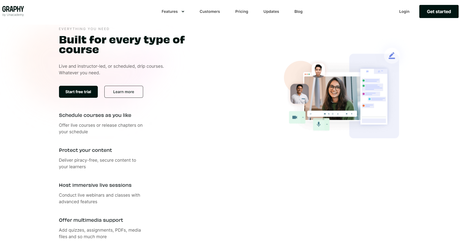In this post, we’ll help you how to choose the perfect online course platform for you.
Picking the right online course platform can be daunting for new course creators. Getting started on your online course journey is a great move.
However, the platform you choose to host your online courses can make a huge difference in the learning experience and your bottom-line earnings.
Whether you are an instructional designer in a traditional sense or a creator with skills, it’s important that you choose a platform that’s designed especially for this purpose.
But how do I decide which platform is the best for me?
In this in-depth guide, we’ll talk about the most important aspects to consider while choosing an online course platform. Not just that, we’ll finalize the platform so you can focus on building your online course, and not get stuck in decision paralysis.
How To Choose The Perfect Online Course Platform: Online Course Platform vs Marketplace
Before we get into details, let’s first understand the difference between two major modes of teaching online.
Online Course Platform
When you choose an online course platform, you make all the major decisions about branding, pricing, and the student enrollment process. It allows you to create your whole online course ecosystem which is scalable and profitable.

With an online course platform or self-hosted platform, you drive your own marketing and create your personal brand. You control and own all the content and students’ data.
Course Marketplace
A marketplace, on the other hand, is like a site where you can sign-up and sell an online course among thousands of others. It’s actually like a virtual market where learners do window shopping before deciding which course to buy.

In most cases, you don’t have control over your pricing and students’ data. Moreover, you can’t create your own personal brand or learners’ community. The most important thing is that there is a substantial revenue share which can massively decrease your profitability.
Winner: Online Course Platform
Hence, an online course platform gives you the power to launch your own platform with your own elements. You have 100% control over your revenue, you can build your own branded community and your learners can learn and grow with you.
Want to know if GreyCampus is worth it? Then you must check out this article about GreyCampus Review, and find out if you should give it a try.
Best way to choose the perfect online course platform
Let’s go over the top 10 things to look for while choosing an online course platform:
1. A great learning experience for your learners
The primary purpose of an online course is to teach something and to impart your knowledge.
So quite clearly, a great platform should allow you to present your course content in the simplest and a structured way.
Your platform should be able to measure your students’ learning and help you translate their new knowledge into practice.
- Can you structure your course into modules and sub-modules?
- Is there an option of drip content?
- Can you see learners’ analytics?
- Can you apply for gamification tools or award certificates?
- Can you take live quizzes and give assignments?
- Most importantly, does the software you choose seem to be a learning management software (LMS), or is it simply a marketing tool/ page builder?
If the answer to most of the above questions is positive, then you have checked one of the most essential criteria. Having these basic features will significantly increase your online program’s value.
Graphy by Unacademy is one such platform that is specially designed for new-age course creators. It lets you structure your course into modules and submodules and allows content dripping. You can create multimedia course content, study student analytics, and reward certificates for your learners.
2. Easy-to-use Interface
This is a no-brainer. In an online world, we hate nothing more than an unresponsive, buggy, and complex platform. If we can’t figure out how to navigate through a platform, we most probably leave that within seconds.
Hence, choose an easy-to-use course platform that will allow you to focus on creating content and maximize your efforts.
An online course software with a straightforward built-in editor. Try to operate the platform as a learner before making the decision.
Remember, if you have to deal with a complicated admin interface, you need a better platform. Creating course content, building lessons, and collecting payments should be a cakewalk.
Most of the online course platforms out there offer free trials of at least 7 days. This gives you the opportunity to explore and finalize what suits your requirement the best.
Graphy, for one, offers a 14-day free trial. Here, you can create and launch your online course with ease.
3. Community Building and Student Engagement
We tend to be invested in something and participate more if there is a sense of belongingness anywhere. In the case of online courses, you can create that sense of belongingness by creating an online community.
If your learners are engaged with your course content and feel part of a community, your course will surely be more successful. Through an online course community, your learners should be able to share their small achievements, blockers, and journey with each other.
Creating engagement in online education
While choosing an online course platform, look for students’ engagement features.
Graphy is a course platform for creators which has all the essential students’ engagement features.
- Rewarding certificates to learners when they reach a certain milestone.
- Course discussion forum for sharing the progress, ideas, tips and congratulating each other for small achievements.
- Doubt clearing on the forum, providing feedback, and more.
- The forum can also be used to interact with each other and develop relationships.
- Graphy has two forums, one is a course discussion forum only for learners and the other is a public forum, which is open to all.
4. A Clear Pricing Structure
Everything ultimately comes down to money. While choosing the online course platform, find the pricing plan that suits your needs and is within your budget.
- Look for a platform that is transparent and has a clear pricing strategy.
- Don’t entertain the platform with hidden charges.
- Factor in the cost of third-party integration if the platform isn’t self-sufficient.
- Steer clear of those platforms that take a commission of your earnings.
Most online course platforms offer multiple pricing options so that they can suit the creators’ needs.
Say no to commission-based platforms. If the monthly fee is low with a commission-based model, factor in the future costs. Calculate how much transaction fees and earning percentage you will pay after making a few sales.
If it’s higher than the flat monthly fee of other platforms, then it might not be the right solution for you. A 5% transaction fee might not seem like much when you are just beginning.
However, if you eventually start making $10,000 from your course, a 5% fee would take away $500 for that month alone. Graphy offers 3 simple pricing plans based on whether or not you need a mobile app.
5. A Support team who is prompt to assist
A stellar support team might not feel like an essential feature in the beginning. But, once you are into the course creation process and can’t figure out how to use a certain feature, it can get downright frustrating.
Launching a new course shouldn’t feel like a nerve-wracking experience! There are multiple nuts and bolts in a successful course launch. Hence, having an expert support team at your disposal is invaluable.
When evaluating course platforms, check out other creators’ reviews. If the platform is not prompt in solving queries or sits behind unending follow-up emails, that’s a red flag. Live chat support or email isn’t worth much if they cannot provide you with actual and prompt answers!
Graphy is known for fabulous customer support. They assigned you personal account managers whom you can reach out to anytime over call or text. They are platform experts who onboard you and solve your queries.
6. A Truly white-labeled Platform
There are a few platforms out there that claim to be a hundred percent white-labeled but are not. Either they have plan-wise limits or the truly white-labeled platform is quite expensive.
Either way, you need to choose a platform that can be aligned with your branding and elements. That way, you can affirm your authority and build solid credibility among your learners.
Having your own brand identity for your online course ecosystem also helps you put forward your unique value proposition and show authority.
Hence, choose a software that’s customizable and white-labeled. Choose your own themes, upload your own logo, and set up your own custom domain. Graphy provides white-labeled course websites and mobile apps.
7. External Integrations
The right course platform is the one that has all the advanced in-built features, while also allowing the integration of your favorite platforms.
Graphy is an all-in-one course creation platform. It has all the basic and advanced in-built features tools you need to launch a successful online course. However, every course business is different and has different needs.
It gives you the ability to connect your online course platform with your favorite external tools so that you don’t have to choose. Well, you can have it all.
Here are a few things to look for in a platform:
- Can you upload content from external sources or is SCORM allowed?
- Can you add integrations from other sites like Google Analytics & Facebook Ads tracking?
- Can you bulk import existing students without upgrading to a more expensive plan?
- Can you integrate Zapier to connect all the tools?
- Do you receive payments directly from your bank account?
8. Data Tracking and Analytics
Having access to data in a graphical way allows you to track your progress. Look for a platform that has a sales dashboard. A sales dashboard provides you with real-time insights into how many learners enrolled in your course in a particular period of time.
Analytics are important to help you understand which course is performing well at what pricing point.

On graphy, you can download your sales report and course report too. The analytics allow you to check your courses’ progress and analyze their performance.
By collecting data, you’ll be able to improvise your course and double down on what’s working.
9. Flexible Payment Plans
While launching your online course you might want to set different pricing strategies. Charging a one-time fee or in installments or creating a bundle at a discounted price are some of the options that creators use. You can also keep a subscription-based model or a membership.
The platform that you choose should be able to provide you with all of these options so that you can A/B test different things for different courses. Evaluate the course’s topic, length, and customer base to find a pricing strategy that is best for you.
Flexibility to choose a pricing plan
When selecting a platform to host your online program, check if they offer the possibility of choosing between different pricing plans to set for your students.
The right course platform should allow you to offer multiple payment plans to your learners. Graphy allows them all. Not just that, you can also create coupon codes, presell your courses, manually bulk enroll students, and do much more.
10. In-built Marketing Tools
No matter how great your online course is, it won’t sell itself. You need to carve out a course promotion plan to make sure you have a successful course launch.
Marketing your online course is an essential part of getting sales, gaining traffic to your course landing page, and getting a stellar course launch.
Launching an online course is just like opening a physical store, only easier. Before you start with your marketing efforts, make sure that your online course platform allows basic in-built marketing features.
- Are you able to connect your domain or subdomain with your course platform?
- Are you able to build customized landing pages?
- Can you add integrations with external apps and insert a tracking code on your website?
- Does it allow UTM source so that you can track conversions?
- Can you send customized web push and app push notifications?
If the answer to the above question is yes, then your platform is good to go!
Choose Graphy to Grow as an Online Educator
Finding that your chosen platform couldn’t work out can be a pain. The whole process of moving to an entirely new platform can be daunting. Hence, it’s important to do your research and stick to something that mostly satisfies your criteria.
As a matter of fact, no platform will be 100% perfect for everyone. There is no single, one-size-fits-all solution. Hence, you need to prioritize what’s important to you and act accordingly.
Rather than getting entangled in the choice and getting stuck in finding the perfect platform, go for something which satisfies most of your criteria and is within your budget.

Graphy is one such platform that is being used by top-notch course creators to run their business smoothly and make sales!
Graphy users don’t spend endless nights trying to create Paypal buttons or link websites! The platform has everything you need to run your business and provide a quality user experience.
It is an all-in-one solution with zero tech problems to create, market, and sell your online courses. Prioritize what features are important to you and get going!
Don’t overthink your choice.
Quick Links:
- How to Make Money on YouTube?
- Jungle Scout Pro Review: Is It Worth Your Money?
- How to Get Free WiFi Anywhere

